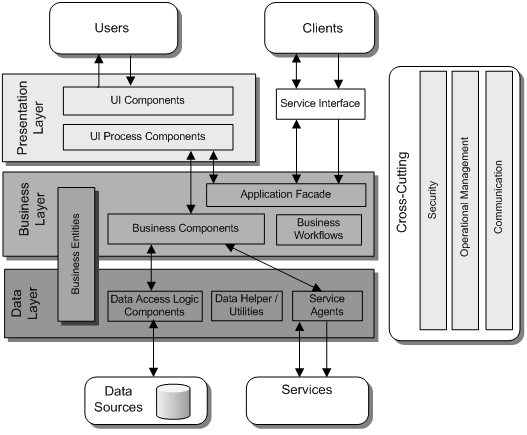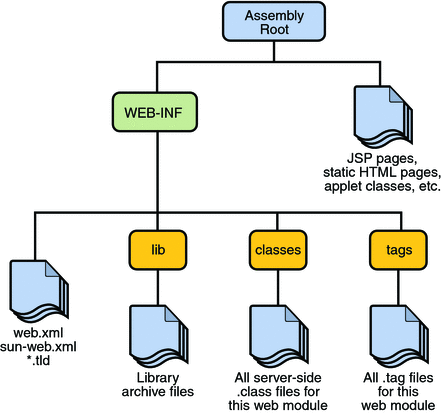Layered Architecture

3 Tier Architecture
- In 3 tier architecture, there are 3 components: Client PC, An Application server and A Database Server.
- The work of server is distributed among application server and database server.
- Application server has the required communication functions.
- The data required by the business logic exists in database server.
- The required data is returned to public servers and then to client PC.
Advantages:
- Improved Data Integrity
- High Degree of Flexibility in deployment platform and configurations
- Improved security
- High Performance and persistent objects
- Architecture is scalable, adding users and resources in future would be easy
- Maintenance and modifications can be done effectively
- Code and data reusability can be achieved
Disadvantages:
- 3 tier architecture is complex compared to 1 tier and 2 tier
- Cost of network maintenance and deployment is greater than 1 tier and 2 tier
The layers of web application are : 1. Presentation Layer. 2. Data Source Layer 3. Domain Logic & Business Logic Layer

Presentation Layer
- The presentation layer is the layer that handles the user interface.
- It is the layer that handles the user interaction with the application.
- The presentation layer provides necessary data to the client’s side.
- It receives input data, processes users’ requests, sends them to data services and puts results to the browser.
- With Java EE, It is handled with JSP, JS, HTML and CSS.
Components:
-
User interface (UI) components
- These components provide the mechanism for users to interact with the application. They format data and render it for display, and acquire and validate data entered by users.
-
UI process components
- To help synchronize and coordinate user interactions, it can be useful to drive the process using separate UI process components.
- This prevents the process flow and state management logic from being hard-coded into the UI elements themselves, and allows you to reuse the same basic user interaction patterns in other user interfaces.
Data Source Layer
- The data source layer is the layer that handles the data services.
- This is where the data arrives at your organization.
- Information is stored and received from a database or file system.
- The information is passed back to the logic tier for processing, and then eventually back to the user.
- With Java EE, It is handled with JDBC, Hibernate, JPA.
Domain Logic & Business Logic Layer
- The domain logic layer is the layer that handles the business logic.
- It uses an application server and processes the business logic for the application.
- With Java EE, It is handled with Servlet.
Design Considerations
- For Presentation Layer
- Use the relevant pattern.
- Design for separation of concerns.
- Design for separation of concerns.
- Consider human interface guidelines.
- Adheres to use driven design principles.
- Business Layer
- Applicate Facade - a facade is an object that serves as a front-facing interface masking more complex underlying or structural code.
- Business Components
- Business Entity Components
- Business Workflow
- Data Access Layer
- Choose the data access technology
- Consider security flaws.
- Use abstraction to implement a lossely coupled interface to the data access layer.
- Decide how you will handle data exception.
- Decide how you will manage connection.
Web Architecture with Java EE
Servlet 🔥
- It is a technology that is used to create enterprise web application.
- Servlet is an API that provides many interfaces and classes including documentation.
- Servlet is an interface that must be implemented for creating any Servlet.
- Servlet is a class that extends the capabilities of the servers and responds to the incoming requests. It can respond to any requests.
- Servlet is a web component that is deployed on the server to create a dynamic web page.
Advantages of Servlet
- Better performance: because it creates a thread for each request, not process.
- Portability: because it uses Java language.
- Robust: JVM manages Servlets, so we don't need to worry about the memory leak, garbage collection, etc.
- Secure: because it uses java language.
Servlet API
javax.servlet.*packagejavax.servlet.http.*package
Packages and Interfaces
| Interface | Package |
|---|---|
Servlet |
javax.servlet.* |
ServletRequest |
javax.servlet.* |
ServletDispatcher |
javax.servlet.* |
GenericServlet |
javax.servlet.* |
HttpServeletRequest |
javax.servlet.http.* |
HttpServletResponse |
javax.servlet.http.* |
HttpSession |
javax.servlet.http.* |
Steps to Develop Web Application
| Steps | Description |
|---|---|
| Step 1 | Develop the web application architecture. |
| Step 2 | Develop the web resources ( HTML File, CSS File, Servlet File). |
| Step 3 | Develop the deployment descriptor (web.xml). |
| Step 4 | Compile the Java file. |
| Step 5 | Deploy the web application. |
| Step 6 | Start Server and access using the web browser. |
Folder Structure

Life Cycle
-
public void init(Servlet config) throws ServletExceptionconfig: It is a configuration object that contains the information about the servlet.- It is called only once.
- It is called only when
Serveletis created and not called when any user requests the servlet. - The
init()method simply creates or load some data that will be used throughout the information of the servlet.
-
public void service(ServletRequest request, ServletResponse response) throws ServletException, IOExceptionrequest: It is a request object that contains the information about the request.response: It is a response object that contains the information about the response.- It is called when any user requests the servlet.
- It is called for each request.
- It is the main method to perform the actual task.
- The Servlet container (i.e. webserver) calls the
service()to handle incoming request and write the formatter and response back to the client. - Each time the server receives the request for a servlet, the server create a new thread to handle the request.
- It checks the HTTP request type (
GET, POST, PUTetc) and calls the appropriate method (doGET(), doPOST(), doPUT()). - When we have nothing to do with service(), we can use the
doGET(),doPOST()method.
public void destroy()- It is called when the servlet is destroyed.
- It is called only once at the end of the lifecycle of the Servlet.
- This method gices your Servlet a chance to clean up any resources that it may have created like: database connections, file handles, etc.
How do you design business logic in yout app using Java EE?
- You must handle the business logic in Domain Layer.
- Benefits of separating the business entities from Controller/UI Layer :
- You can reuse the business entities with another client sections.
Example : if you are developing a web based application as UI, later you also developed a Desktop UI. In this case you can reuse your Business Layer operations with multiple UIs. You can also use business layer to work as a web service. - Decoupled business operations are easier to manage. If someone from development team has no idea how UI code works and only wants to correct some business logic, he can does.
- You can reuse the business entities with another client sections.